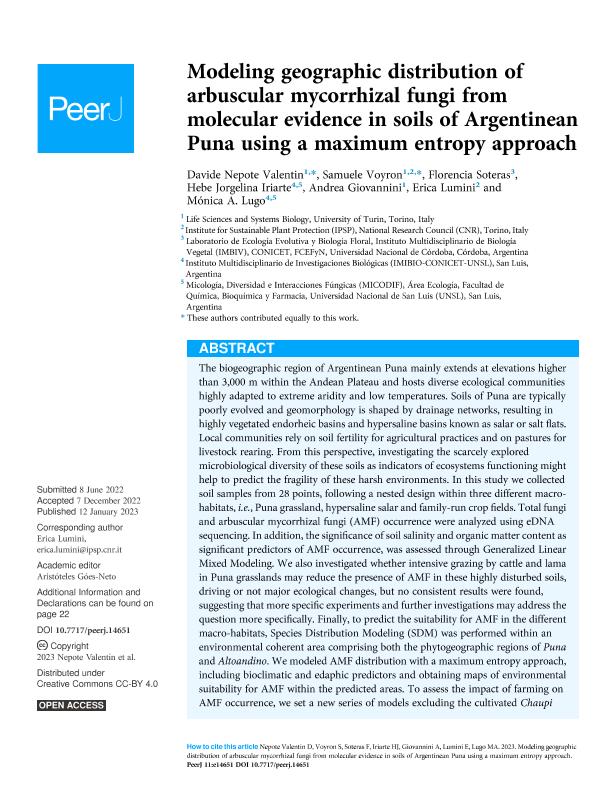Mostrar el registro sencillo del ítem
dc.contributor.author
Nepote Valentin, Davide
dc.contributor.author
Voyron, Samuele
dc.contributor.author
Soteras, María Florencia

dc.contributor.author
Iriarte, Hebe Jorgelina

dc.contributor.author
Giovannini, Andrea
dc.contributor.author
Lumini, Erica
dc.contributor.author
Lugo, Mónica Alejandra

dc.date.available
2023-12-28T13:17:00Z
dc.date.issued
2023-01-12
dc.identifier.citation
Nepote Valentin, Davide; Voyron, Samuele; Soteras, María Florencia; Iriarte, Hebe Jorgelina; Giovannini, Andrea; et al.; Modeling geographic distribution of arbuscular mycorrhizal fungi from molecular evidence in soils of Argentinean Puna using a maximum entropy approach; PeerJ, Inc.; PeerJ; 11; 12-1-2023; 1-30
dc.identifier.issn
2167-8359
dc.identifier.uri
http://hdl.handle.net/11336/221762
dc.description.abstract
The biogeographic region of Argentinean Puna mainly extends at elevations higher than 3,000 m within the Andean Plateau and hosts diverse ecological communities highly adapted to extreme aridity and low temperatures. Soils of Puna are typically poorly evolved and geomorphology is shaped by drainage networks, resulting in highly vegetated endorheic basins and hypersaline basins known as salar or salt flats. Local communities rely on soil fertility for agricultural practices and on pastures for livestock rearing. From this perspective, investigating the scarcely explored microbiological diversity of these soils as indicators of ecosystems functioning might help to predict the fragility of these harsh environments. In this study we collected soil samples from 28 points, following a nested design within three different macro-habitats, i.e., Puna grassland, hypersaline salar and family-run crop fields. Total fungi and arbuscular mycorrhizal fungi (AMF) occurrence were analyzed using eDNA sequencing. In addition, the significance of soil salinity and organic matter content as significant predictors of AMF occurrence, was assessed through Generalized Linear Mixed Modeling. We also investigated whether intensive grazing by cattle and lama in Puna grasslands may reduce the presence of AMF in these highly disturbed soils, driving or not major ecological changes, but no consistent results were found, suggesting that more specific experiments and further investigations may address the question more specifically. Finally, to predict the suitability for AMF in the different macro-habitats, Species Distribution Modeling (SDM) was performed within an environmental coherent area comprising both the phytogeographic regions of Puna and Altoandino. We modeled AMF distribution with a maximum entropy approach, including bioclimatic and edaphic predictors and obtaining maps of environmental suitability for AMF within the predicted areas. To assess the impact of farming on AMF occurrence, we set a new series of models excluding the cultivated Chaupi Rodeo samples. Overall, SDM predicted a lower suitability for AMF in hypersaline salar areas, while grassland habitats and a wider temperature seasonality range appear to be factors significantly related to AMF enrichment, suggesting a main role of seasonal dynamics in shaping AMF communities. The highest abundance of AMF was observed in Vicia faba crop fields, while potato fields yielded a very low AMF occurrence. The models excluding the cultivated Chaupi Rodeo samples highlighted that if these cultivated areas had theoretically remained unmanaged habitats of Puna and Altoandino, then large-scale soil features and local bioclimatic constraints would likely support a lower suitability for AMF. Using SDM we evidenced the influence of bioclimatic, edaphic and anthropic predictors in shaping AMF occurrence and highlighted the relevance of considering human activities to accurately predict AMF distribution.
dc.format
application/pdf
dc.language.iso
eng
dc.publisher
PeerJ, Inc.
dc.rights
info:eu-repo/semantics/openAccess
dc.rights.uri
https://creativecommons.org/licenses/by-nc-sa/2.5/ar/
dc.subject
ARGENTINEAN PUNA
dc.subject
SPECIES DISTRIBUTION MODELING (SDM)
dc.subject
FUNGAL METABARCODING
dc.subject
ARBUSCULAR MYCORRHIZAL FUNGI (ANF)
dc.subject
MAXENT
dc.subject.classification
Ecología

dc.subject.classification
Ciencias Biológicas

dc.subject.classification
CIENCIAS NATURALES Y EXACTAS

dc.title
Modeling geographic distribution of arbuscular mycorrhizal fungi from molecular evidence in soils of Argentinean Puna using a maximum entropy approach
dc.type
info:eu-repo/semantics/article
dc.type
info:ar-repo/semantics/artículo
dc.type
info:eu-repo/semantics/publishedVersion
dc.date.updated
2023-12-13T11:22:29Z
dc.journal.volume
11
dc.journal.pagination
1-30
dc.journal.pais
Estados Unidos

dc.journal.ciudad
San Diego
dc.description.fil
Fil: Nepote Valentin, Davide. University Of Turin. Life Sciences And Systems Biology; Italia
dc.description.fil
Fil: Voyron, Samuele. University Of Turin. Life Sciences And Systems Biology; Italia. National Research Council; Italia
dc.description.fil
Fil: Soteras, María Florencia. Consejo Nacional de Investigaciones Científicas y Técnicas. Centro Científico Tecnológico Conicet - Córdoba. Instituto Multidisciplinario de Biología Vegetal. Universidad Nacional de Córdoba. Facultad de Ciencias Exactas Físicas y Naturales. Instituto Multidisciplinario de Biología Vegetal; Argentina
dc.description.fil
Fil: Iriarte, Hebe Jorgelina. Consejo Nacional de Investigaciones Científicas y Técnicas. Centro Científico Tecnológico Conicet - San Luis. Instituto Multidisciplinario de Investigaciones Biológicas de San Luis. Universidad Nacional de San Luis. Facultad de Ciencias Físico Matemáticas y Naturales. Instituto Multidisciplinario de Investigaciones Biológicas de San Luis; Argentina. Universidad Nacional de San Luis; Argentina
dc.description.fil
Fil: Giovannini, Andrea. University of Turin. Life Sciences And Systems Biology; Italia
dc.description.fil
Fil: Lumini, Erica. Institute For Sustainable Plant Protection ; Italia. National Research Council; Italia
dc.description.fil
Fil: Lugo, Mónica Alejandra. Consejo Nacional de Investigaciones Científicas y Técnicas. Centro Científico Tecnológico Conicet - San Luis. Instituto Multidisciplinario de Investigaciones Biológicas de San Luis. Universidad Nacional de San Luis. Facultad de Ciencias Físico Matemáticas y Naturales. Instituto Multidisciplinario de Investigaciones Biológicas de San Luis; Argentina. Universidad Nacional de San Luis; Argentina
dc.journal.title
PeerJ
dc.relation.alternativeid
info:eu-repo/semantics/altIdentifier/url/https://peerj.com/articles/14651
Archivos asociados
